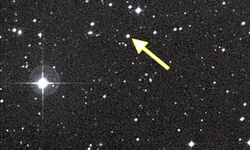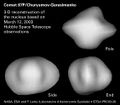Astronomy:SMSS J031300.36−670839.3
| Observation data Equinox J2000.0]] (ICRS) | |
|---|---|
| Constellation | Hydrus |
| Right ascension | 03h 13m 00.36s[1] |
| Declination | −67° 08′ 39.3″[1] |
| Apparent magnitude (V) | 14.7[1] |
| Characteristics | |
| Evolutionary stage | red giant[1] |
| Astrometry | |
| Distance | 6000 ly (1800 pc) |
| Details | |
| Surface gravity (log g) | 2.3[1] cgs |
| Temperature | 5,125[1] K |
| Metallicity [Fe/H] | ≤ −7.1 (<3D>,nLTE)[1] dex |
| Age | 13.6 Gyr |
| Other designations | |
| Database references | |
| SIMBAD | data |
SMSS J031300.36−670839.3 (shortened as SMSS J0313−6708;[2] informally abbreviated to SM0313[3]) is a star in the Milky Way at a distance of 6,000 ly (1,800 pc) from Earth. With an age of approximately 13.6 billion years,[4] it is one of the oldest stars known. Another star, HD 140283, was considered to be older, but there is uncertainty in values of its age. This makes SM0313 the oldest known star with an accurate determination of its age.[5][6][7] The star formed only about 100 million years after the Big Bang and has been shining for 13.6 billion years. The star's very low upper limit of iron of less than one ten-millionth the iron level of the Sun,[8] suggests that it is one of the first Population II stars, formed from a gas cloud enriched by some of the first (Population III) stars.[6] SMSS J031300.36-670839.3 also has a much higher carbon supply compared to iron, more than a thousand times greater.[6] Apart from hydrogen, which appeared in the Big Bang, the star also contains carbon, magnesium, and calcium, which could have been formed in a low-energy supernova.[8] Methylidyne (CH) is also detected by its absorption line. No oxygen or nitrogen has been detected.[1] The star is a K-class red giant.[5]
The star was discovered by a team led by Australian National University astronomers.[7] The discovery was reported in Nature on 9 February 2014[1] and indicates that the supernovae of the population III stars may not have been as powerful as previously thought.[6]
The discovery was made possible by the SkyMapper,[7] a fully automated optical telescope at Siding Spring Observatory near Coonabarabran, New South Wales, Australia.[8]
| Elements | [M/H] |
|---|---|
| Lithium | 0.7 |
| Carbon | −2.6 |
| Magnesium | −3.8 |
| Calcium | −7 |
See also
- HD 140283
- HE 1327-2326
- SDSS J102915+172927
- HE 1523-0901
- HE0107-5240
- BD +17° 3248
- HD 122563
- Sneden's Star
- Cayrel's Star
References
- ↑ 1.0 1.1 1.2 1.3 1.4 1.5 1.6 1.7 1.8 1.9 Keller, S. C.; Bessell, M. S.; Frebel, A.; Casey, A. R.; Asplund, M.; Jacobson, H. R.; Lind, K.; Norris, J. E. et al. (2014). "A single low-energy, iron-poor supernova as the source of metals in the star SMSS J031300.36−670839.3". Nature 506 (7489): 463–466. doi:10.1038/nature12990. PMID 24509711. Bibcode: 2014Natur.506..463K.
- ↑ 2.0 2.1 The Kavli Foundation (24 September 2014). "Most metal-poor star hints at universe's first supernovae". https://www.sciencedaily.com/releases/2014/09/140924135022.htm.
- ↑ Kooser, A. (10 February 2014). "Astronomers track down oldest known star in the universe". http://news.cnet.com/8301-17938_105-57618634-1/astronomers-track-down-oldest-known-star-in-the-universe/.
- ↑ Nicholson, L. (10 February 2014). "New star found by ANU researchers may lead to universal truth". http://www.smh.com.au/technology/sci-tech/new-star-found-by-anu-reserchers-may-lead-to-universal-truth-20140209-32ae2.html.
- ↑ 5.0 5.1 Gary, S. (12 February 2014). "Oldest known star reveals early Universe". StarStuff. ABC Science. http://www.abc.net.au/science/audio/2014/02/12/3942556.htm.
- ↑ 6.0 6.1 6.2 6.3 "Researchers identify one of the earliest stars in the universe". Massachusetts Institute of Technology. 9 February 2014. http://web.mit.edu/newsoffice/2014/researchers-identify-one-of-the-earliest-stars-in-the-universe-0209.html.
- ↑ 7.0 7.1 7.2 Brainard, C. (10 February 2014). "The Archaeology of the Stars". New York Times. https://www.nytimes.com/2014/02/11/science/space/the-archaeology-of-the-stars.html.
- ↑ 8.0 8.1 8.2 Keller, S. (10 February 2014). "The oldest star discovery tells much about the early universe". The Conversation Media Group. http://theconversation.com/the-oldest-star-discovery-tells-much-about-the-early-universe-22944.
Coordinates: ![]() 03h 13m 00.36s, −67° 08′ 39.3″
03h 13m 00.36s, −67° 08′ 39.3″
 |





